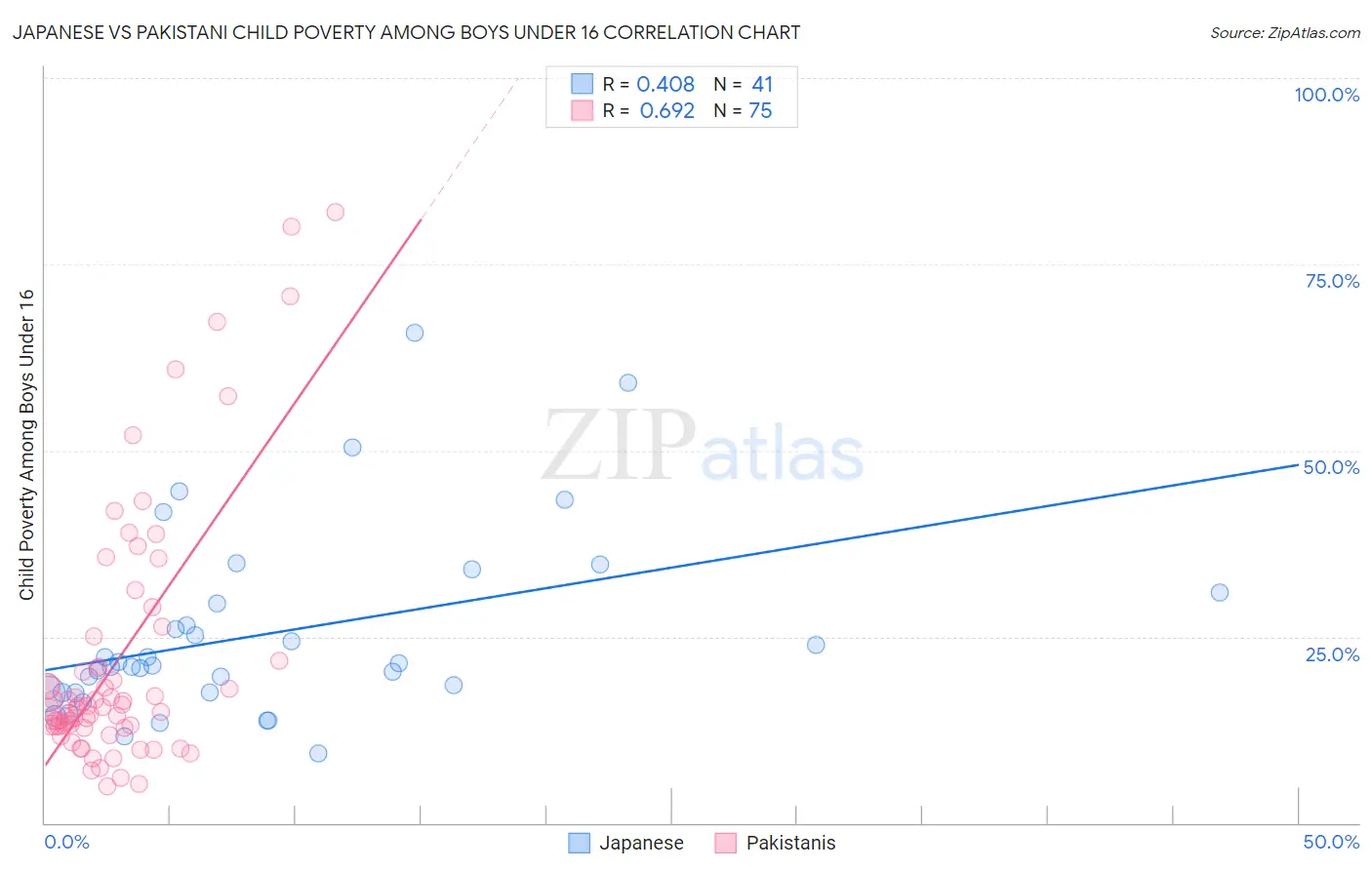Japanese vs Pakistani Child Poverty Among Boys Under 16
COMPARE
Japanese
Pakistani
Child Poverty Among Boys Under 16
Child Poverty Among Boys Under 16 Comparison
Japanese
Pakistanis
17.7%
CHILD POVERTY AMONG BOYS UNDER 16
5.5/ 100
METRIC RATING
217th/ 347
METRIC RANK
15.1%
CHILD POVERTY AMONG BOYS UNDER 16
94.7/ 100
METRIC RATING
109th/ 347
METRIC RANK
Japanese vs Pakistani Child Poverty Among Boys Under 16 Correlation Chart
The statistical analysis conducted on geographies consisting of 247,557,395 people shows a moderate positive correlation between the proportion of Japanese and poverty level among boys under the age of 16 in the United States with a correlation coefficient (R) of 0.408 and weighted average of 17.7%. Similarly, the statistical analysis conducted on geographies consisting of 331,571,147 people shows a significant positive correlation between the proportion of Pakistanis and poverty level among boys under the age of 16 in the United States with a correlation coefficient (R) of 0.692 and weighted average of 15.1%, a difference of 17.4%.

Child Poverty Among Boys Under 16 Correlation Summary
| Measurement | Japanese | Pakistani |
| Minimum | 9.3% | 4.9% |
| Maximum | 65.7% | 82.1% |
| Range | 56.4% | 77.1% |
| Mean | 25.4% | 21.9% |
| Median | 21.1% | 15.5% |
| Interquartile 25% (IQ1) | 17.5% | 13.0% |
| Interquartile 75% (IQ3) | 30.2% | 21.7% |
| Interquartile Range (IQR) | 12.7% | 8.7% |
| Standard Deviation (Sample) | 12.6% | 17.2% |
| Standard Deviation (Population) | 12.5% | 17.1% |
Similar Demographics by Child Poverty Among Boys Under 16
Demographics Similar to Japanese by Child Poverty Among Boys Under 16
In terms of child poverty among boys under 16, the demographic groups most similar to Japanese are Iraqi (17.7%, a difference of 0.020%), Moroccan (17.7%, a difference of 0.030%), Sierra Leonean (17.8%, a difference of 0.10%), Osage (17.7%, a difference of 0.12%), and Panamanian (17.7%, a difference of 0.19%).
| Demographics | Rating | Rank | Child Poverty Among Boys Under 16 |
| Immigrants | Armenia | 6.8 /100 | #210 | Tragic 17.6% |
| Immigrants | Immigrants | 6.7 /100 | #211 | Tragic 17.6% |
| Aleuts | 6.6 /100 | #212 | Tragic 17.7% |
| Immigrants | Eastern Africa | 6.0 /100 | #213 | Tragic 17.7% |
| Panamanians | 5.9 /100 | #214 | Tragic 17.7% |
| Osage | 5.8 /100 | #215 | Tragic 17.7% |
| Moroccans | 5.6 /100 | #216 | Tragic 17.7% |
| Japanese | 5.5 /100 | #217 | Tragic 17.7% |
| Iraqis | 5.5 /100 | #218 | Tragic 17.7% |
| Sierra Leoneans | 5.3 /100 | #219 | Tragic 17.8% |
| Immigrants | Cambodia | 5.1 /100 | #220 | Tragic 17.8% |
| Immigrants | Panama | 4.3 /100 | #221 | Tragic 17.9% |
| Pennsylvania Germans | 3.9 /100 | #222 | Tragic 17.9% |
| Cubans | 3.8 /100 | #223 | Tragic 17.9% |
| Nepalese | 3.2 /100 | #224 | Tragic 18.0% |
Demographics Similar to Pakistanis by Child Poverty Among Boys Under 16
In terms of child poverty among boys under 16, the demographic groups most similar to Pakistanis are Immigrants from England (15.1%, a difference of 0.040%), Jordanian (15.1%, a difference of 0.21%), English (15.1%, a difference of 0.26%), Immigrants from Zimbabwe (15.2%, a difference of 0.31%), and Serbian (15.1%, a difference of 0.32%).
| Demographics | Rating | Rank | Child Poverty Among Boys Under 16 |
| Romanians | 95.6 /100 | #102 | Exceptional 15.0% |
| Immigrants | Denmark | 95.6 /100 | #103 | Exceptional 15.0% |
| Immigrants | Switzerland | 95.4 /100 | #104 | Exceptional 15.0% |
| Dutch | 95.4 /100 | #105 | Exceptional 15.0% |
| Serbians | 95.2 /100 | #106 | Exceptional 15.1% |
| Jordanians | 95.1 /100 | #107 | Exceptional 15.1% |
| Immigrants | England | 94.8 /100 | #108 | Exceptional 15.1% |
| Pakistanis | 94.7 /100 | #109 | Exceptional 15.1% |
| English | 94.3 /100 | #110 | Exceptional 15.1% |
| Immigrants | Zimbabwe | 94.2 /100 | #111 | Exceptional 15.2% |
| Basques | 93.8 /100 | #112 | Exceptional 15.2% |
| Irish | 93.8 /100 | #113 | Exceptional 15.2% |
| Immigrants | Ukraine | 93.6 /100 | #114 | Exceptional 15.2% |
| Armenians | 93.6 /100 | #115 | Exceptional 15.2% |
| Immigrants | South Eastern Asia | 93.5 /100 | #116 | Exceptional 15.2% |